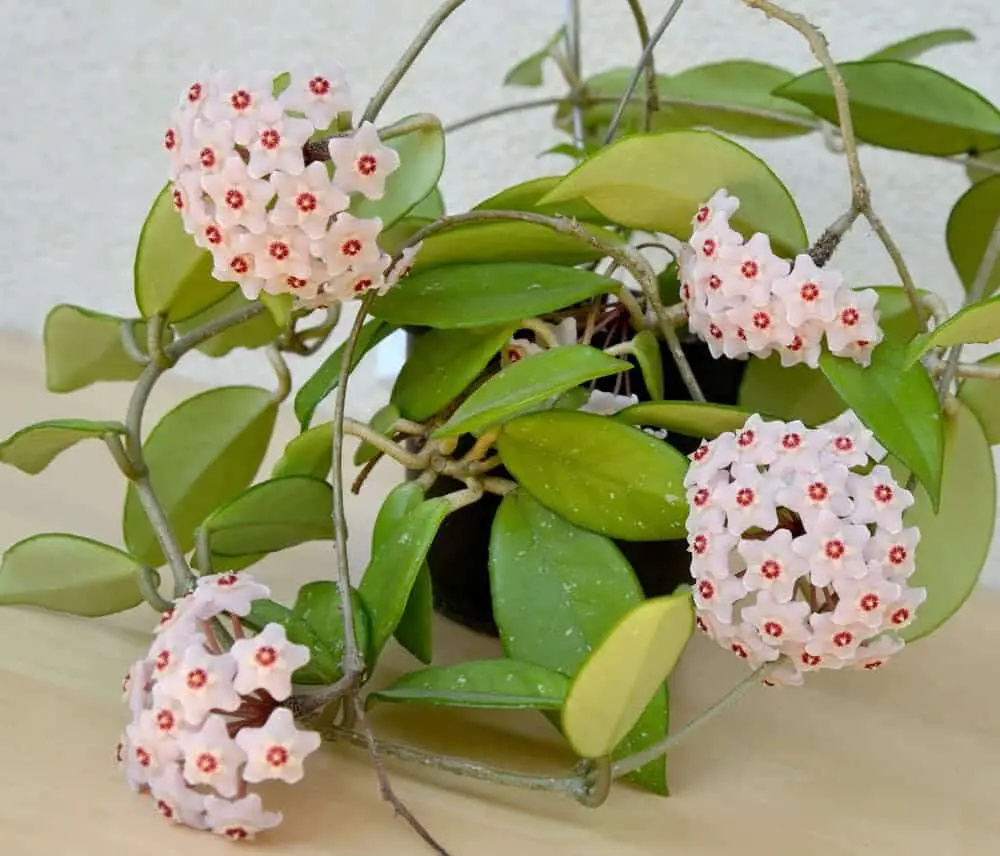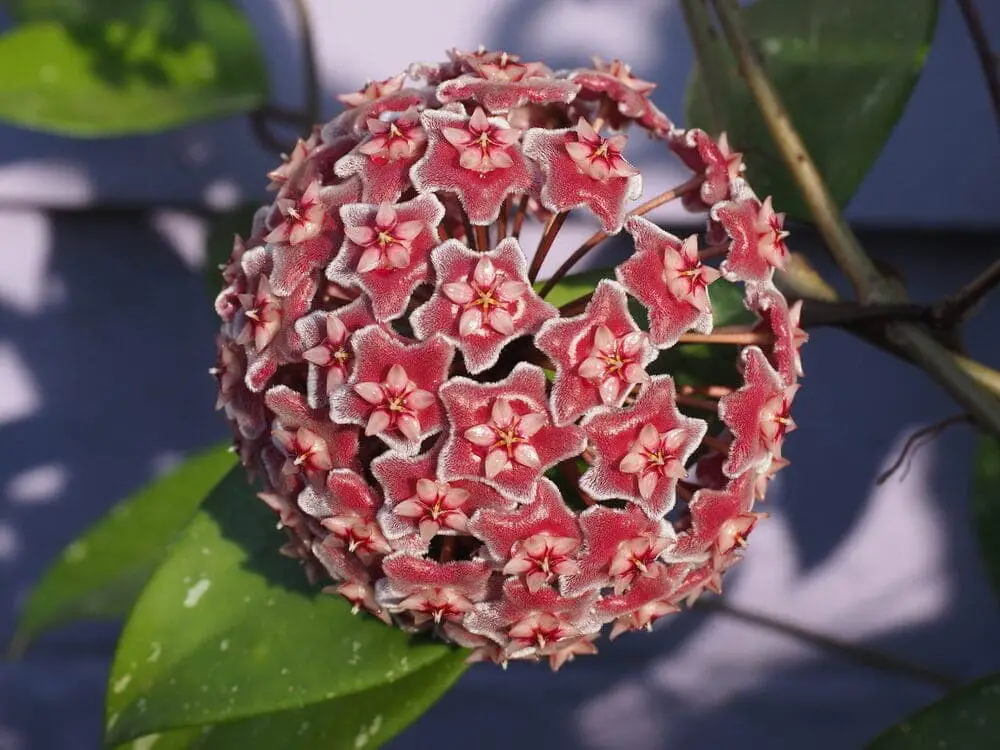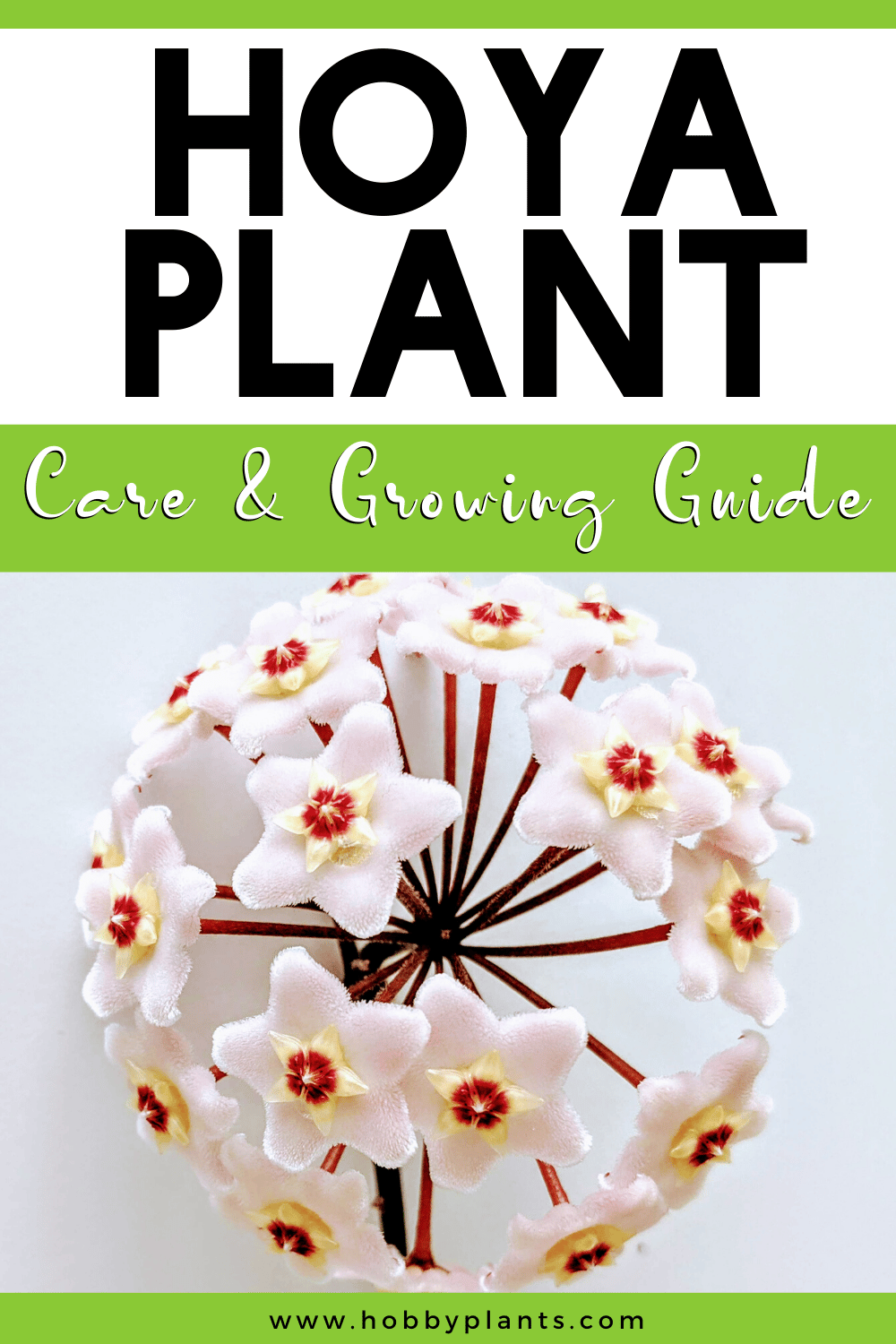The Hoya plant is an excellent houseplant, especially for those with a busy lifestyle.
The reasons are that they require little attention to watering and they only need partial sunlight. The Hoya plant has the unique ability to pull moisture out of the air to help maintain their well-being.
In addition to being a great houseplant, they are now becoming popular once again with home gardeners.
Hoya Plant Care & Growing Guide
1. Light Requirement
The Hoya plant will need full to partial sun. If the plant does not receive at least a half-day of sunlight, it may not produce any flowers. They can tolerate full sun in the spring and fall, but in the summer the full sun can cause color bleaching or scorched leaves. Your Hoya plant should have at least six hours of indirect and bright sunlight each day.
2. Water
You should water the Hoya plant sparingly and only when the soil is dry. They live naturally in low-water environments. During the spring and summer is when it needs the most water because it is going through its yearly growth spurt. It will need extra water to expand and bloom. When you water the plant, do not allow the water to pool or flood the pot.
In the fall and winter, you will have to water the Hoya plant about once a month.
3. Climate
USDA Hardiness Zone 10-12. In other zones, you can grow it as a tropical container plant.
4. Soil
This plant does not like heavy soil so you should mix your potting soil in a 1-to-1 ratio with orchid potting soil. The soil also needs to be well-draining.
5. Temperature
If you are putting your Hoya planter outside, you need to bring them indoors when the temperature drops below 50 degrees Fahrenheit. The best temperature for a Hoya plant would be 60-70 degrees Fahrenheit. It will tolerate humidity well. A Hoya plant will go dormant in the fall and winter because of the cooler temperatures.

6. Repotting
Hoya plants are different from other plants in which they like to be a little root bound in order to produce flowers. When you see roots starting to appear around the drainage holes you will know it is time to repot them. It is best to repot them in the spring or early summer. This is when it is in its active growing stage. You want to use a pot that is no bigger than one to two inches taller and wider than the current pot. If you give the plant too much space, it can stunt their flowering ability. They like snug pots.
Make sure that it is not repotted any lower than it was in the current pot. A Hoya plant needs some airflow around it to avoid damage like decay or rot.
7. Speed of Growth
.Because it is a perennial, it will take several years to grow to its full height.
8. Height and Spread
The full height and length of the plant are between two and four feet, with some growing taller.
9. Flowers
The flowers of the Hoya plant come in a variety of colors with flowers that range in size from one-fourth inch to four inches in diameter. The flowers will often bloom in clusters. Some of the flowers are fragrant while others have a waxy appearance. Each cluster of flowers may contain 40 individual flowers that are packed together tightly. They will often have a colored eye in the center of the corona. They will bloom during the summer months.
10. Trimming
They are a hardy plant but do require some light maintenance. Remove any damaged, dead, or wilted branches and leaves. Many times thee will have a brownish or yellowish color. If any of the plants seems diseased you need to get rid of it too. Most of the time, diseased parts of the Hoya plant will have a dusty or chalky look.
Do any trimming with caution because the new flower growth can grow on older flower stems so you want to make sure that you do not remove these spurs. They will flower year after year. Make sure if you are trimming the trailing arms, you do not trim too much. They are necessary because if it cannot grow in size, it will not fill the planter and produce flowers.

Is Hoya Plant Poisonous?
Yes, when ingested, it is poisonous to animals and humans but not when it is touched.
Can Hoya Plant grow in Water?
When re-growing a Hoya plant, you can use stem cuttings from the new growth or softer wood. The cuttings should be four to six inches long with just a few leaves. Root them in water and then you can plant them when their roots start to grow.
How to get Hoya Plant to Flower?
Get rid of the dead blooms, make sure they have the right light and temperature, and watered sparingly.
Also read: Chrysanthemum Care & Growing Guide
Common Plant Diseases
Hoya Plant is prone to a variety of diseases, including:
- Sap sucking bugs like spider mites, aphids, and mealy bugs—you can use a soapy water mixture and spray the leaves to get rid of them or a spray of Neem oil.
- Sooty mold—it is a black mold that forms on leaves that are sticky with sap. All you do is wipe off the mold with a damp cloth.
- Fungal root rot—this happens if they are overwatered so be careful how much you water them.
- Botyris blight—this is a grayish fungal patch near the center of the plant. You can treat this with a copper fungicide.
Similar post:
Conclusion
- The Hoya plant is considered a tropical flower that is low maintenance.
- They are part of the Asclepiadaceae family, which is also known as the milkweed family.
- The Hoya plant is also known as a wax plant, porcelain flower, or honey pot.
- It can be allowed to trail over the side of the container or train it as a vine.
- When it finishes blooming, leave the stalk as it could produce new flowers
- The Hoya plant are light feeders so giving them a monthly drink of diluted fish emulsion or compost tea will give it all the nutrients it needs.
- In the family of Hoya plants, there are 200-300 different species that have multiple different cultivars.

Victoria is the owner and main author of hobby plants. She loves spending her free time in her garden planting and taking care of her plants. Victoria hopes you enjoy the content here!
![Mother Of Thousands Plant [Complete Plant Care Guide] Mother Of Thousands Plant [Complete Plant Care Guide]](https://www.hobbyplants.com/wp-content/uploads/2022/07/mother-of-thousands-plant-300x158.jpg)
![Majesty Palm Plant Care: [Complete Beginner's Guide] Majesty Palm Plant Care: [Complete Beginner's Guide]](https://www.hobbyplants.com/wp-content/uploads/2022/08/majesty-palm-care-300x158.jpg)
![Exotic Angel Plant Care: [Complete Beginner's Guide] Exotic Angel Plant Care: [Complete Beginner's Guide]](https://www.hobbyplants.com/wp-content/uploads/2022/08/exotic-angel-plant-care-300x158.jpg)
![Snow White Waffle Plant: [Complete Care Guide] Snow White Waffle Plant: [Complete Care Guide]](https://www.hobbyplants.com/wp-content/uploads/2022/08/snow-white-waffle-plant-300x158.jpg)
![Waffle Plant Care: [Complete Beginner's Guide] Waffle Plant Care: [Complete Beginner's Guide]](https://www.hobbyplants.com/wp-content/uploads/2022/08/waffle-plant-300x158.jpg)
![Bird Of Paradise Plant Care: [Complete Beginner's Guide] Bird Of Paradise Plant Care: [Complete Beginner's Guide]](https://www.hobbyplants.com/wp-content/uploads/2022/08/bird-of-paradise-plant-300x158.jpg)
![Purple Passion Plant Care: [Complete Beginner's Guide] Purple Passion Plant Care: [Complete Beginner's Guide]](https://www.hobbyplants.com/wp-content/uploads/2022/08/purple-passion-plant-care-300x158.jpg)
![China Doll Plant Care: [Complete Beginner's Guide] China Doll Plant Care: [Complete Beginner's Guide]](https://www.hobbyplants.com/wp-content/uploads/2022/09/china-doll-plant-care-300x158.jpg)
![Polka Dot Plant Care: [Complete Beginner's Guide] Polka Dot Plant Care: [Complete Beginner's Guide]](https://www.hobbyplants.com/wp-content/uploads/2022/09/polka-dot-plant-300x158.jpg)
![Mona Lisa Lipstick Plant Care: [Complete Beginner's Guide] Mona Lisa Lipstick Plant Care: [Complete Beginner's Guide]](https://www.hobbyplants.com/wp-content/uploads/2022/09/lipstick-plant-mona-lisa-300x158.jpg)
![Yucca Cane Plant Care: [Complete Beginner's Guide] Yucca Cane Plant Care: [Complete Beginner's Guide]](https://www.hobbyplants.com/wp-content/uploads/2022/09/yucca-cane-plant-care-300x158.jpg)
![Bush On Fire Croton Plant Care: [Complete Beginner's Guide] Bush On Fire Croton Plant Care: [Complete Beginner's Guide]](https://www.hobbyplants.com/wp-content/uploads/2022/09/bush-on-fire-croton-300x158.jpg)